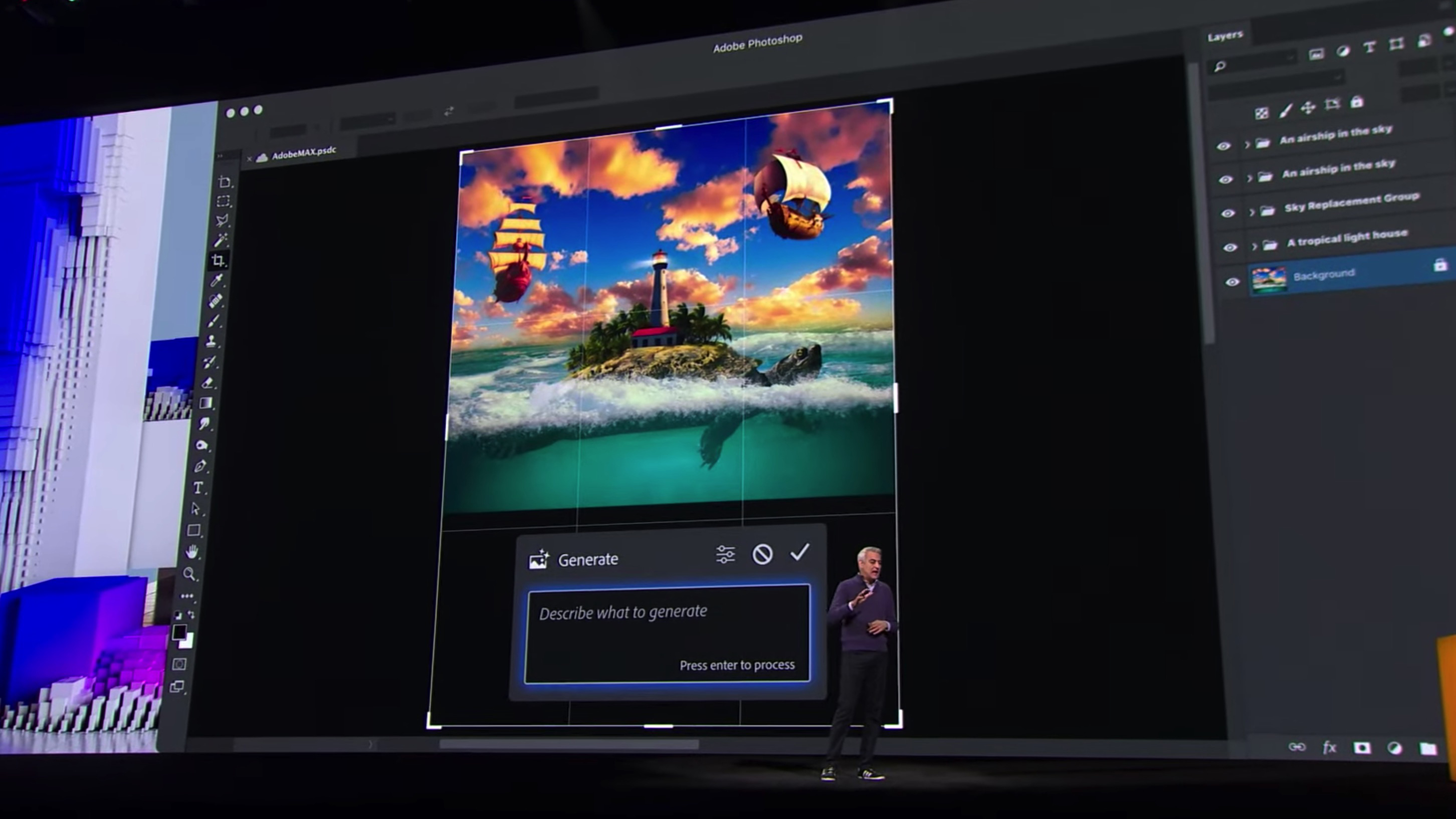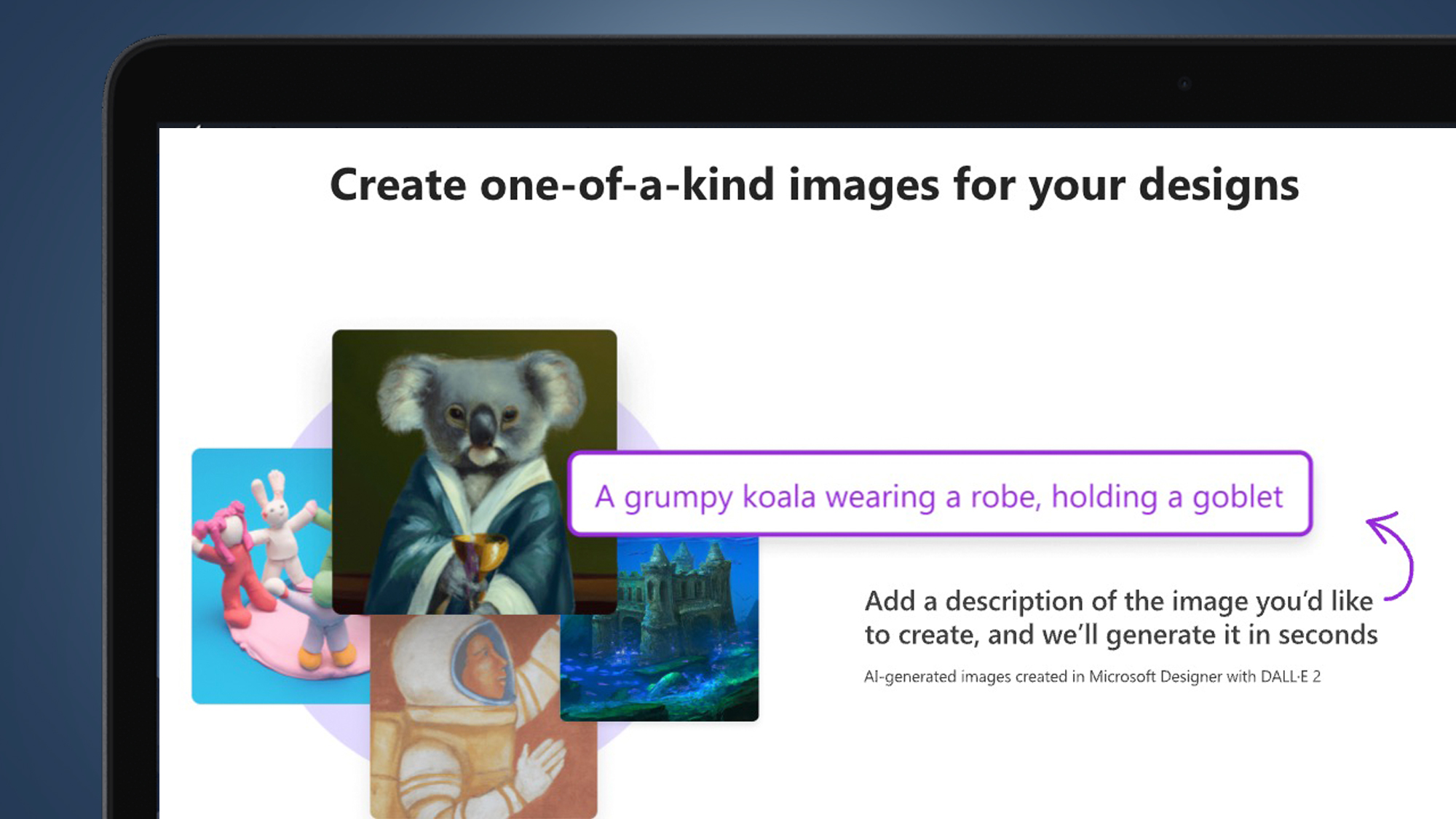This year's Adobe Max 2022 went big on 3D design and mixed-reality headsets, but the AI-generated elephant in the room was the rise of text-to-image generators like Dall-E. How is Adobe planning to respond to these revolutionary tools? Slowly and cautiously, according to the keynote – but a significant feature buried in the new version of Photoshop shows the process has already started.
Towards the end of the release notes for the latest Photoshop v24.0 is a beta feature called 'Backdrop neural filter'. What does this do? Like Dall-E and Midjourney, it lets you "create a unique backdrop based on a description". You just type in a backdrop, select 'Create', and pick your favorite result.
This is a long way from being Adobe's Dall-E rival, though. It's only available in Photoshop Beta, a test-bed that's separate from the main app, and you're currently restricted to typing in colors to produce different photo backdrops, rather than bizarre concoctions from the darkest corners of your imagination.
But the 'Backdrop neural filter' is clear evidence that Adobe is, however cautiously, dipping its toes further into AI image generation. And its keynote speech at Adobe Max shows that it thinks this frictionless method of creating visual imagery is undoubtedly the future of Photoshop and Lightroom – once it's sorted out the small matter of copyright issues and ethical standards.
Creative co-pilots
Adobe didn't really mention the arrival of the 'Backdrop neural filter' at Adobe Max 2022, but it did lay out where the technology will ultimately end up.
David Wadhwani, Adobe's President of Digital Media Business, effectively said that the company has all the same technology as Dall-E, Stable Diffusion and Midjourney; it's just chosen not to apply it in its apps yet. "Over the last few years, we've been investing more and more in Adobe Sensei, our AI engine. I like to refer to as Sensei as your creative co-pilot," Wadhwani said.
"We're working on new capabilities that can take our core flagship applications to whole new levels. Imagine being able to ask your creative co-pilot in Photoshop to add an object to the scene simply by describing what you want, or asking your co-pilot to give you an alternative idea based on what you've already built. It's like magic," he added. It certainly goes a few steps further than Photoshop's Sky Replacement tool.

He said this while standing in front of a mocked-up version of what Photoshop would look like with Dall-E powers (above). The message was clear – Adobe could do text-to-image generation on this scale right now, it's just chosen not to.
But it was Wadhwani's Lightroom example that showed how this kind of technology could be more sensibly integrated into Adobe's creative apps.
"Imagine if you could combine 'gen-tech' with Lightroom. So you can ask Sensei to transform night into day, a sunny photograph into a beautiful sunset. Move shadows or change the weather. This is all possible today with the latest advances in generative technology," he explained, with an unsubtle nod to Adobe's new rivals.
So why hold back while others steal your AI-generated fries? The official reason, and one that certainly has some merit, is that Adobe has a responsibility to make sure this new power isn't wielded recklessly.
"For those of you not familiar with generative AI, it can conjure up an image simply from a text description. And we're really excited about what this can do for all of you but we also want to do this thoughtfully," Wadhwani explained. "We want to do this in a way that protects empowers and champions the needs of creators."
What does this mean in practice? While it's still a little vague, Adobe will moving slower and more carefully than the likes of Dall-E. "Here's our commitment to you," Wadhwani told the Adobe Max audience. "We're approaching generative technology from a creator-centric perspective. We believe AI should enhance human creativity, not replace it, and it should benefit creators not replace them."
This goes some way to explaining why Adobe has, so far, only gone as far as Photoshop's 'Backdrop neural filter'. But that's also only part of the story.
The long game
Despite being the giant incumbent of creative apps, Adobe is undoubtedly still very innovative – just check out some of the projects in Adobe Labs, particularly the ones that can turn real-world objects into 3D digital assets.
But Adobe is also susceptible to being blindsided by fast-moving rivals. The likes of Photoshop and Lightroom have been built as desktop-first tools, which means Canva has stolen a march on it for user-friendly, cloud-based design tools. This is why Adobe splurged $20bn on Figma last month, a figure that's more than Facebook paid for WhatsApp in 2014.

Is the same thing happening with the likes of Dall-E and Midjourney? Quite possibly, as Microsoft has just announced that Dall-E 2 will be integrated into its new Designer graphic design app (above), which is part of its 365 productivity suite. AI image generators are flying towards the mainstream, in spite of Adobe's misgivings about the speed at which this is happening.
And yet Adobe does also have a point about the ethical issues surrounding this fascinating new technology. There's a considerable copyright cloud growing over the rise of AI image generation – and it's understandable that one of the founders of the Content Authenticity Initiative (ICA), which is designed to tackle deepfakes and other manipulated content, might balk at going all-out on generative AI.
Still, Adobe Max 2022 and the arrival of the 'Backdrop neural filter' show that AI image generation is undoubtedly going to be a big part of Photoshop, Lightroom and photo editing in general – it just might take a while longer to appear in your favorite Adobe app.
from TechRadar - All the latest technology news https://ift.tt/KExO0iM
No comments:
Post a Comment